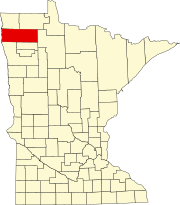Como Township, Marshall County, Minnesota
Como Township was organized in 1900, and named after Lake Como in St. Paul, Minnesota.
Geography
According to the United States Census Bureau, the township has a total area of 36.3 square miles (94 km), all land.
Demographics
As of the census of 2000, there were 52 people, 21 households, and 17 families residing in the township. The population density was 1.4 inhabitants per square mile (0.54/km). There were 37 housing units at an average density of 1.0 per square mile (0.39/km). The racial makeup of the township was 100.00% White.
There were 21 households, out of which 28.6% had children under the age of 18 living with them, 66.7% were married couples living together, 9.5% had a female householder with no husband present, and 19.0% were non-families. 19.0% of all households were made up of individuals, and 4.8% had someone living alone who was 65 years of age or older. The average household size was 2.48 and the average family size was 2.82.
In the township the population was spread out, with 17.3% under the age of 18, 13.5% from 18 to 24, 34.6% from 25 to 44, 28.8% from 45 to 64, and 5.8% who were 65 years of age or older. The median age was 42 years. For every 100 females, there were 116.7 males. For every 100 females age 18 and over, there were 138.9 males.
The median income for a household in the township was $39,167, and the median income for a family was $39,167. Males had a median income of $26,563 versus $25,000 for females. The per capita income for the township was $12,950. None of the population or the families were below the poverty line.
References
- ^ "U.S. Census website". United States Census Bureau. Retrieved January 31, 2008.
- ^ "US Board on Geographic Names". United States Geological Survey. October 25, 2007. Retrieved January 31, 2008.
- ^ Upham, Warren (1920). Minnesota Geographic Names: Their Origin and Historic Significance. Minnesota Historical Society. p. 327.
